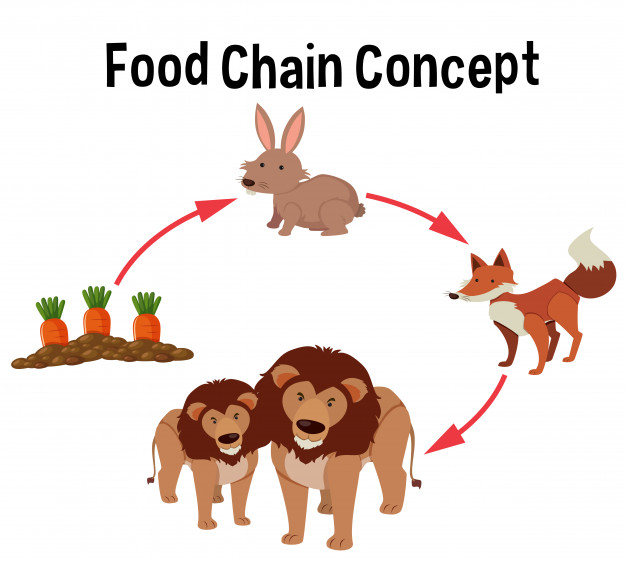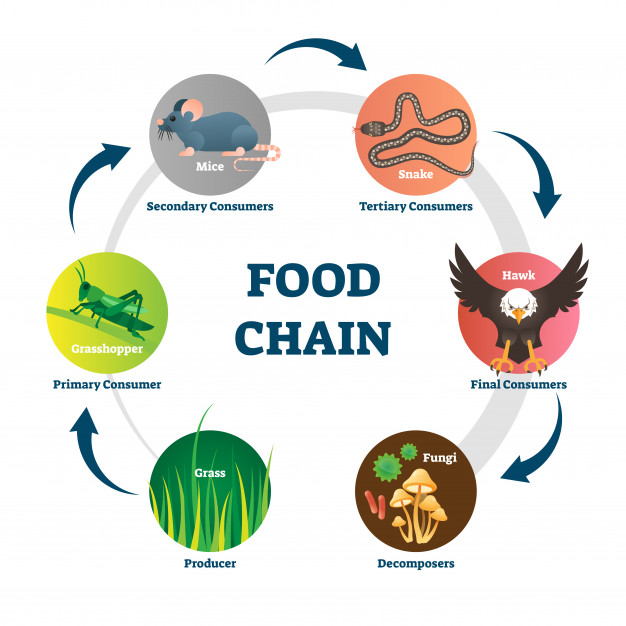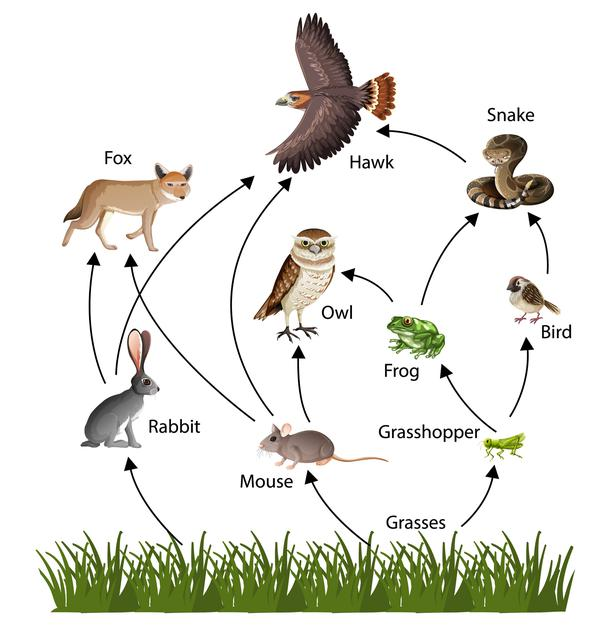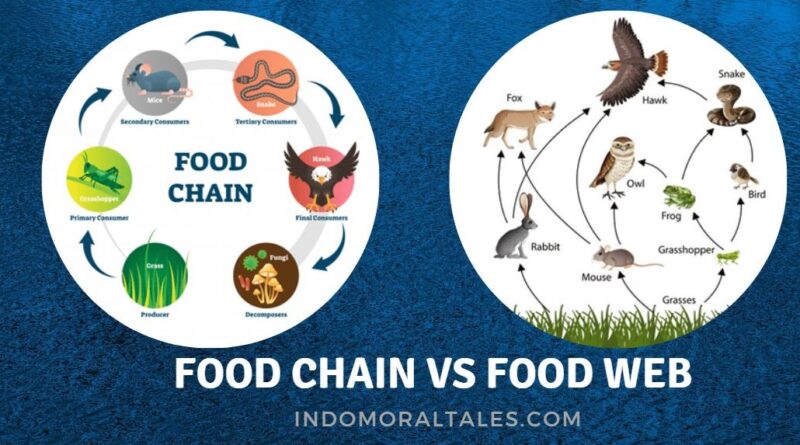Difference Between The Food Chain and The Food Web?
At the heart of food consumption for any animal in any ecosystem is one thing: energy. Energy can take multiple paths, and the types of paths depend on various other factors. How the animals consume this energy and the path energy takes from one species to the other defines a food chain and a food web.
This article will outline all the differences between the food chain and the food web.
Let us start with the tabular form of difference of food chain and food web.
| The food chain | The food web |
| The energy follows a single, linear path. | The energy is interconnected to multiple paths among various species. |
| It can be long, short, or anywhere in between. | There is no length since all paths are interconnected. |
| The chain ends when the top predator consumes the energy. | There is no one endpoint. |
| A food chain exists irrespective of the ecosystem. | A food web takes into account various ecosystems at the same time. |
| The food chain is the most basic form of a food web. | A food web consists of multiple food chains. |
| Energy flowing in a food chain is a straight line. | Energy flowing through a food web is a pyramid. |
| We cannot divide the food chain into more levels. | We can divide a food web into at least three more levels in the shape of a pyramid. |
These differences are explained further below.
Quick Navigation
1. A food chain is a straight line, but a food web isn’t
There are diverse ecosystems that exist in the world — forest, lake, pond, and others. Each one of them includes a food chain. The food chain is the most basic form of a food web because every animal in an ecosystem needs the energy to survive.
They get that energy by consuming a member of the species below them. For example, a rabbit may eat a plant, and a tiger might kill and eat that rabbit. This way, we already have a food chain:
Plant -> rabbit -> tiger

Whoever consumes that tiger will be on top of the food chain as the top predator. If no animal eats the tiger, then the tiger itself is the top predator. It marks the end of the food chain. This way, there is only one linear path in a food chain. The energy flows from the plant to the rabbit and the rabbit to the tiger.
However, this is not the case in the food web, which is many times more complex than the simple food chain. In a food web, energy flows from one level to the other in a pyramid-like structure, as we will see below. In essence, the food web shows how the organisms and species of a community interact with one another through their food preferences and habits.
2. The food web has many levels, but the food chain has only one level

Because the food chain is a linear pathway for the flow of energy, it does not require any levels to explain the flow. In a food web, however, there are at least three levels:
Level 1: Producers such as plants
The most basic level in a food web is the producers. Species in this group do not rely on other animals or organisms to produce their food because they have the tools to do it on their own.
Plants are the primary example in this group. Plants and their various species do not need other animals for photosynthesis. Their structure contains the tools and chemicals needed to perform this function. So they survive well without interdependency.
These plants are known as foundation species because they are responsible for creating the food that other animals use for their own survival. These plants mark the beginning of the food web and are thus an important aspect of the community because of the change and impact they have.
Level 2: Consumers such as animals
At this level, animals such as rabbits, tigers, giraffes, and others exist. Because animals eat each other as well, this group is further divided into three main categories. They are primary, secondary, and tertiary animals.
- Primary animals eat the producers directly. They rarely rely on other animals for survival. Examples are rabbits and giraffes.
- Secondary animals rely on primary animals for their food. They only eat these herbivore animals and not animals that consume animals.
- Tertiary animals are the group where the food web gets more interesting. These animals eat both the primary and secondary animals. This concept means that these animals eat both herbivores and animals that eat those herbivores.
There may be many sub-categories along with these main categories depending on the type and variety of species.
- There is a fourth main category that involves tiny microorganisms and organisms that are responsible for returning important nutrients back to Earth. Such organisms are decomposers because they rely on dead plants and animals for their survival.
3. The food web is more useful than a food chain to predict changes in an ecosystem
A food chain is just a simple transfer of energy from one organism to another. In a food web, however, we can learn a lot more about how various species of animals consume one another.

We can also learn about how the energy flows in a complex way up through the pyramid, all the way to a top predator. The pyramid-like flow also helps us understand more about how one level of animals impacts the other.
We learn about the interdependency of these species and how affecting one of them will impact every other level that’s dependent on that one.
- For example, when people are burning trees for agriculture or large forest areas are burning because of wildfires, the basic level of the food web, the trees, are vanishing at an alarming rate.
- Their disappearance means that the herbivores such as rabbits and giraffes no longer have their main meal, which in turn affects the bigger and more complex species higher up on the food chain who rely on these herbivores.
- This is one such example where scientists are using a food web to understand how one level is dependent on the other.
4. Food web shows both direct and indirect interactions, but the food chain only shows direct interaction among species
From the pyramid structure, we can clearly see the direct connections between different levels. In addition to this depiction, a food web also shows how different species interact both directly and indirectly. Our knowledge about indirect interaction is often as important as direct interaction.

For example, in one such experiment, a scientist found that the presence of starfish in a lake, where it originally did not belong, increased the competition among other species like smaller fishes for the same amount of food, which was otters in this case.
The scientist found that such changes in the ecosystem heavily influence how species interact with their ecosystem and compete for food. In some cases, it helps ecosystems thrive and multiply because the competition is very fierce.
5. We can understand a food web from top to bottom or vice versa
When we first look at a food web, we see a pyramid structure. The shape tells us that the animals and birds in the higher levels are dependent and controlled by their resources in the lower levels.
To give another perspective, if we look at the structure from bottom to top, we will notice that the producers such as plants are in fact controlled by how many species are present at a higher level.
- To test this theory, scientists conducted an experiment in which they increased and decreased the number of tigers in a forest. Since tigers are the predators, their presence increased or decreased the number of rabbits, for example, present in the forest.
- In another such example, the scientists suggest that there is adequate greenery in our world because the consumers eat the herbivores and prevent them from consuming all the plants present in our world.
- The same is the case with birds. The scientists found that the weed population is controlled where birds lived and the trees grew out of control in their absence.
Conclusion:
Both food chains and food webs give us important information about ecosystems and energy transfer.
There are important differences in how the energy flows in food chains and food webs, but we can think of food chains to be the basic first step in building a food web. The food web requires connections between producers and consumers, and the food chains provide those connections.
In many cases, the food web gives us more information than the food chain about the ecosystem, its inhabitants, and the way they consume energy. The food web also teaches us how energy flows in complex ecosystems, and how changing one part will invariably affect all the others present in the same ecosystem.
All in all, both food chains and food webs tell us a lot about the world that we live in and the food that we eat. Learning about the nuances in our ecosystems will help us take care of them better.




